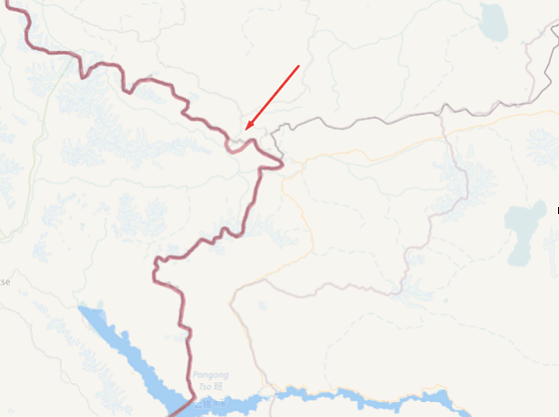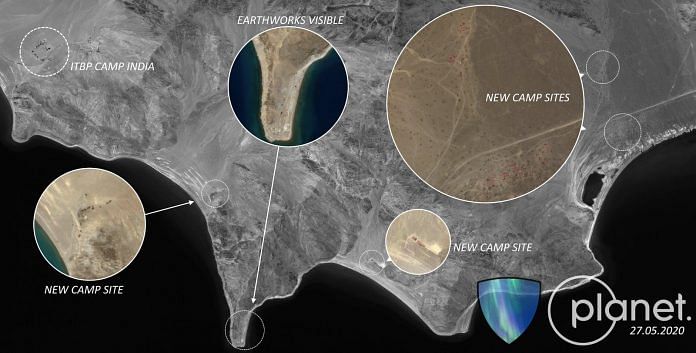If Pangong was a case of rapid drive-through intrusions by both India and China across the Line of Actual Control, and Galwan a case of a somewhat longer intrusion that was vacated, then the Hotsprings-Gogra area is the region that has seen the most significant armed build-up on the Chinese side in the past few weeks.
Image 1 shows the location of the Gogra region with respect to Pangong, sourced from Chinese mapping company AutoNavi and superimposed on OpenStreetMap. The red arrow points to the Gogra region. Near the arrow is a faint grey line, which is the Indian interpretation of the Line of Actual Control (LAC), and a red U-curve, which is the Chinese interpretation.

Image 2 shows both Indian (red) and Chinese (yellow) interpretations of the LAC stencilled by hand onto the layout of the area. Four points of interest are marked with yellow pins. The Indian base can be seen at the south, whereas two points of concern (POC) can be seen to its north and one point of concern to its east. All 3 POCs are well inside the Chinese side of the LAC.

In our scans of the area, we were not able to detect any intrusions by the Chinese across the red line in Image 2 above. We did, however, notice several Indian and Chinese minor posts, with probably no more than 3 to 5 persons each, facing the red line within their respective territories. No Chinese post was observed between the red and yellow lines.
Also read: Huawei continues 5G push in India with Covid-focused tech, despite anti-China sentiment
The Chinese bases
A classified and proprietary report in the possession of the Ministry of Defence, seen by us, notes the Chinese buildup in detail, which has been described here.
The two northern points (in Image 2) show a pool of offensive equipment. Armoured vehicles and their support vehicles can be seen (marked armoured pool) in the northern-most point. The southern of the two points, a little closer to the Indian border, shows significant gun emplacement (marked towed artillery unit).
The point marked ‘armoured motor pool’ shows a set of constructions and vehicles. What is interesting is that the northern vehicle cluster comprises 10 clearly visible infantry combat vehicles of the Russian BMP (Boyevaya Mashina Pekhoty) type. These are highly mobile vehicles on tracks, with large calibre guns that stood out despite these vehicles being covered by tarpaulin. Given their location in the valley and their mobility, they could ingress into the Indian territory in short order.
At the point marked ‘towed artillery unit’, a powerful artillery emplacement of 12 large-calibre field howitzers (152 or 155mm calibre) can be seen. At no point, in the time series surveillance of these platforms, was the position or the orientation of the field artillery changed. The orientation of these artillery pieces is not towards the Indian camp, but could, within minutes, be reoriented.
The eastern point turned out to be a large permanent base of concrete with several mobile shelters, tents, trucks, earth-moving equipment and a concrete slab with a shed that could easily function as a large helipad and hangar – holding about four to six helicopters at any given time. Significantly, there are 11 BMP-type infantry combat vehicles. Given that this is a concrete base, the additional tents and mobile shelters indicate that the beefing up of this base was recent and the troops brought in were a temporary augmentation.
Looking at all three points, the Chinese have clearly deployed a significant force — between 1,000 to 1,500 Chinese troops, or a battalion and a half, and firepower.
Moreover, the classified and proprietary Ministry of Defence report states that this particular build-up started around the first week of May and reached its peak around the third week, once the situation started flaring up in the public discourse.
Also read: Chinese troops present in sizeable numbers at LAC, India has done what’s needed: Rajnath
Contrast to Pangong
The big difference between the build-ups in Gogra and Pangong is that in Gogra, the build-up has been recent whereas Pangong has seen an almost negligible build-up. Over the surveillance period, since end-April, we were hard-pressed to find any increase in armour or vehicle deployment around Pangong.
The Chinese artillery emplacement, stationed there in May 2019, remained in position, but has not been augmented. This is about a kilometre away from the LAC. The Chinese base at the foot of Finger 7, as seen in Image 3, remained where it was with no additional troops, but a small encampment of Chinese tents emerged at the foot of Finger 4, well within the Chinese side of the LAC, comprising a few tents.

A new high resolution Image 4 confirms that the build-up at Finger 4 in Pangong is minimal at best, involving no more than 200 troops. West of the Foxhole Point ridge, we can see a new Indian camp housing approximately 40-60 soldiers. To the east on the Chinese side, three new camps have come up holding approximately 100 to 150 soldiers cumulatively. In Foxhole Point itself, Chinese earth moving equipment can be seen. These indicate new excavation, but no new asphalt being laid, contradicting reports of a new phase of “blacktopping” happening.

As can be seen in Image 5 from 2019, the emplacement is highly unusual in that it is an artillery ‘fort’, something not really seen in modern warfare. Lying 23 kilometre east of the Indo-Tibetan Border Police (ITBP) camp at Finger 4 of Pangong, it is almost a medieval fort and contains eight large calibre howitzers (either 152 or 155 mm) and two guns of a different make, which we interpret as anti-aircraft artillery, in order to protect the site from possible air attacks. This artillery emplacement faces a small residential base presumably for the gunners and supplies.

There is also a small Chinese base at the foot of Finger 7, probably holding around 200 troops. This has been around at least since 2004 (see Image 3).
What is significant here, though, is that none of these positions has been augmented or reinforced in the last four weeks – neither troops, nor vehicles and weapons. It is, however, well developed and given the clearing of land, could be scaled up in short order. We did manage to trace the boats used in the foxhole point skirmish (described in part 1 of this series) to this base. It seems almost exclusively of a naval orientation, with a white radome housing a surface search radar to scan any boats on the Pangong lake.
Finally, we have the new development (Image 6) that shows a small cluster of two large Chinese tents capable of holding no more than 60 troops together. This new Chinese encampment lacked any ancillary infrastructure seen in the ITBP base across the ridge of Finger 4 on the Indian side. Contrast this Chinese encampment with the much larger ITBP base on the Indian side with permanent structures.

Also read: Northern Commander in Ladakh, Army moves more troops amid standoff with China
The danger at Gogra
While Gogra has seen the least cross-border activity – be it drive-throughs or longer incursions, it gives the most cause for worry given the recent large scale build-up in the area.
On the bright side, we could not find evidence of Chinese troops occupying the heights anywhere in Galwan or Gogra. Troops occupying heights leave tell-tale signs – you will see bunkers constructed for protection that require days if not weeks to build; you will see trails for resupplying these bases; if these bases get threatened, then you will see signs of large calibre weaponry being hauled up. Nowhere was this visible in our four-week and ongoing surveillance.
None of this, of course, minimises the seriousness of the build-up in Gogra, which does justify the concern.
It is, then, safe to conclude the following:
Pangong: There has been some movement and the Chinese have consolidated their position west of Finger 4. There have been rapid incursions in this region
— Galwan saw a minor incursion, now repulsed, but China has retaliated by withholding water, which will have serious consequences if not challenged.
— Gogra has seen no incursions yet, but a significant and recent military build-up has taken place on the Chinese side.
Abhijit Iyer-Mitra is Senior Fellow with the institute of Peace and Conflict Studies. Views are personal.
This is the third article in a three-part series, focussing on the Hotsprings-Gogra area. Part 1 focussed on Pangong and Part 2 on the Galwan area.




India is demoralizing it’s army, by not giving a stand to face off Chinese. Pakistan will also access that India has given up to the Chinese army. What about Amit shah boosting in Parliament about Aksai chin and POK?
Doesn’t this article contradict Defence Minister Rajnath Singh’s statement that there are a sizable number of Chinese soldiers present at the LAC? Is Rajnath Singh right or this article? If there is really a military standoff between China and India why is the Indian government taking such a squeamish stand vis a vis China? When India withdrew Article 370 and 35A China took it to the UNO and was quite vocal in its criticism of India but India is deafeningly silent on the Chinese move in Hong Kong. There is no belligerence shown by the Indian leadership while China has been very anti-India in every international forum; may it be our entry into NSG or the issue of Masood Azhar. As a tit for a tat India could have a taken a firm anti-China stand with regard to Taiwan and Hong Kong. When the whole world is contemplating forcing China to comply with an international enquiry into the origins of Coronavirus India, for reasons best known to it, remained silent for the most part. It is intriguing diplomacy by India or has China succeeded in browbeating India into submission?
CNN News 18 clarified the same..
So according to the writer, Chinese are on their side and we are on our side and basically that is all there is to it. So then what is the story? Why create such a fuss? After a couple of months, Modi and Xi will be meeting somewhere in Inner Mongolia, holding hands and swinging and all will be forgotten.
And who believes you still? Spouting imaginary statistics and writing middle-brow English does not make you an iota more believable. BJP is unleashing its best Soi-disant intellectuals to tell an impossible story. Try harder, boot-licker.
Dont be a dumb idiot.. Go and check for yourself on Google Earth and Planet Earth.. But then do you even have the basic skills at map reading?
It’s very much appreciated that the author tries to underline his arguments with OSint numbers and maps. Even though I am not sure if the maps provided are current and precise enough. If there’s a mature discussion of other opinions, those arguments should as well be made with facts and figures.
If everything is ok as writer suggest then why not modi declare that no chinese enter in indian territory.